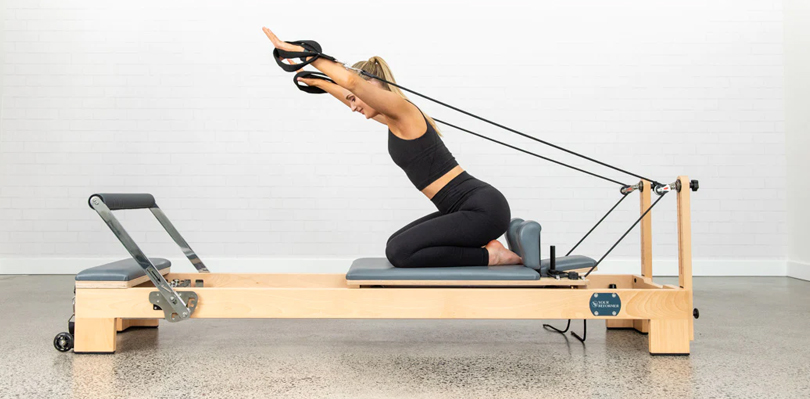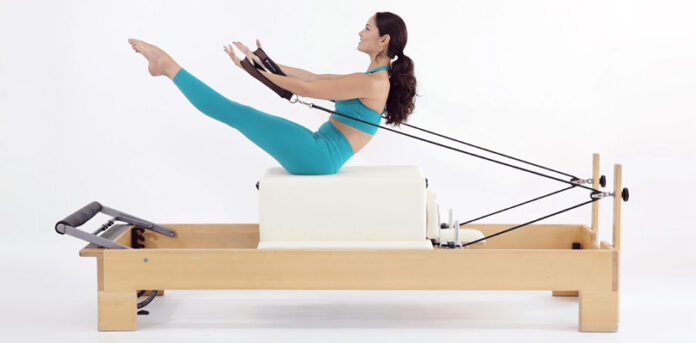Welcome to the world of Reformer Pilates, where strength, flexibility, and mind-body connection come together in a harmonious fitness routine. If you’re seeking a transformative exercise experience that goes beyond the ordinary, you’re in the right place. In this blog post, we’ll unlock the secrets of these Pilates, guiding you through its principles, techniques, and incredible benefits.
Whether you’re a seasoned practitioner or a newbie looking to enhance your fitness journey, our comprehensive guide will empower you with knowledge, motivation, and practical tips. Discover how this dynamic form of Pilates can sculpt your body, improve posture, relieve stress, and enhance your overall well-being. Get ready to embark on a path to vitality, as we delve deep into the world of Reformer Pilates, where every stretch, every move, and every breath counts. Let’s embark on this transformative journey together!
What Are Reformer Pilates
Reformer Pilates is a highly effective and versatile form of exercise that combines elements of traditional Pilates with the use of a specialized apparatus called the “reformer.” This apparatus consists of a sliding carriage, adjustable springs, straps, and a pulley system. During these Pilates sessions, individuals engage in a wide range of controlled and precise movements that target various muscle groups, with resistance provided by the springs.
Reformer Pilates offers numerous benefits, including improved core strength, flexibility, balance, and posture. It also enhances muscular endurance while minimizing impact on the joints, making it suitable for people of all fitness levels. The adjustable nature of the reformer allows for tailored workouts that can address specific fitness goals and accommodate various body types and abilities.
How To Do Reformer Pilates

Here are some steps to do Reformer Pilates:
Set Up Your Reformer
Begin by adjusting the reformer’s springs to your desired resistance level. Typically, beginners start with lighter resistance, while more advanced practitioners may opt for heavier tension. Ensure that the carriage is well-lubricated for smooth movement.
Proper Body Alignment
Before you start any exercises, focus on your body alignment. Sit on the carriage with your feet securely placed against the foot bar and your hands holding the straps. Your spine should be in a neutral position, and your shoulders relaxed.
Breathing Techniques
Pilates emphasizes controlled breathing. Inhale deeply through your nose, expand your ribcage, and then exhale fully through your mouth, engaging your core muscles as you breathe out. Maintain this controlled breathing throughout your workout.
Engage Your Core
Initiate every movement by engaging your core muscles. Imagine pulling your navel towards your spine to create a stable and strong center.
Practice Basic Movements
Start with foundational exercises like leg presses, chest presses, or hamstring curls. These movements help you become familiar with the reformer and work on major muscle groups.
Progress Gradually
As you become more confident and comfortable, you can advance to more complex exercises. These might include exercises that involve lifting your legs, arms, or both while maintaining proper form and balance.
Focus On Control And Precision
Pilates is all about controlled and precise movements. Pay attention to the quality of each movement rather than the quantity. Maintain proper alignment, and avoid jerky or fast motions.
Cool Down And Stretch
Finish your Reformer Pilates session with a series of stretching exercises. These stretches help increase flexibility, prevent muscle soreness, and promote relaxation. Ensure that you stretch each major muscle group.
Remember that Reformer Pilates is most effective when practiced regularly, so aim for consistent sessions to experience the full range of benefits it offers. Additionally, it’s a good idea to start with a certified Pilates instructor who can provide guidance, correct your form, and tailor the exercises to your fitness level and goals.
Benefits Of Reformer Pilates
Here are some benefits of Reformer Pilates:
Improved Core Strength
Reformer Pilates places a strong emphasis on engaging the core muscles throughout each exercise. The moving carriage and resistance from the springs challenge your abdominal muscles, resulting in a stronger and more stable core. This core strength is essential for maintaining proper posture and reducing the risk of lower back pain.
Enhanced Flexibility
Reformer Pilates incorporates a wide range of stretching exercises that help improve flexibility. Regular practice can lead to increased joint mobility and muscle suppleness, reducing the risk of injury and promoting better overall mobility in daily life.
Balanced Muscle Development
Reformer Pilates exercises are designed to work for various muscle groups in a balanced manner. This balanced muscle development helps prevent muscle imbalances, which can lead to poor posture and discomfort. It also contributes to a toned and sculpted physique.
Better Posture
Reformer Pilates emphasizes proper body alignment and awareness. Through consistent practice, you’ll become more conscious of your posture and develop the strength and flexibility needed to maintain a healthy, upright position. This can alleviate issues related to poor posture, such as neck and back pain.
Increased Mind-Body Connection
Reformer Pilates encourages mindfulness and focus on each movement. This mind-body connection helps you better understand your body’s mechanics, improve coordination, and refine your proprioception (awareness of your body’s position in space). It fosters a sense of control and precision in your movements.
Low-Impact Workout
Reformer Pilates is gentle on the joints, making it suitable for individuals of all fitness levels, including those with joint issues or injuries. The controlled movements and adjustable spring resistance reduce the impact on your joints while providing an effective full-body workout.
Stress Reduction And Mental Well-Being
Like other forms of exercise, Reformer Pilates releases endorphins, which are natural mood boosters. Additionally, the focused and controlled movements can have a meditative quality, reducing stress and promoting relaxation. It’s an excellent way to unwind and recharge both physically and mentally.
Incorporating Reformer Pilates into your fitness routine can lead to a host of physical and mental benefits, from a stronger core and improved flexibility to reduced stress levels and a heightened sense of well-being. Whether you’re looking to enhance your athletic performance, rehabilitate from an injury, or simply improve your overall fitness, Pilates offers a versatile and rewarding path to achieving your goals.
Tips To Do Reformer Pilates
Here are a few tips to help you get the most out of your Reformer Pilates practice:
Start With Professional Instruction
If you’re new to Reformer Pilates, it’s essential to begin with professional instruction. A certified Pilates instructor can teach you proper form, technique, and alignment, ensuring that you perform exercises safely and effectively. They will also tailor the workout to your individual needs and fitness level, helping you progress at the right pace.
Focus on Core Engagement
Core engagement is the foundation of Reformer Pilates. Before you begin any exercise, concentrate on activating your core muscles. Visualize pulling your navel toward your spine to create a stable center. Maintaining this engagement throughout your workout not only enhances the effectiveness of each exercise but also protects your lower back.
Mindful Breathing
Pay close attention to your breath during Reformer Pilates. Inhale deeply through your nose, expand your ribcage, and then exhale fully through your mouth. Coordinate your breath with your movements, using the exhale to engage your core and provide stability. Proper breathing enhances control and helps you stay focused.
Adjust Spring Resistance
The reformer’s spring resistance can be adjusted to suit your fitness level and the specific exercise you’re performing. Start with lighter resistance for beginners and gradually increase it as you gain strength and confidence. Remember that the goal is to maintain control throughout the movement, so choose a resistance level that allows for proper form.
Maintain Proper Alignment
Proper body alignment is crucial in these Pilates to prevent strain and injury. Ensure that your spine remains in a neutral position during exercises. Keep your shoulders relaxed, neck long, and wrists straight. Pay attention to the alignment of your limbs, and avoid overextending or hyperextending joints. Regularly check your alignment in a mirror or with the guidance of an instructor.
By following these tips and maintaining a dedicated Reformer Pilates practice, you can experience improved strength, flexibility, posture, and overall well-being while minimizing the risk of injury. Remember that patience and persistence are key to mastering this transformative form of exercise.
FAQs
What is the difference between Mat Pilates and Reformer Pilates, and why choose Reformer?
Mat Pilates and Reformer Pilates both originate from the same principles but differ in execution. Mat Pilates primarily uses body weight for resistance, while these Pilates utilize specialized equipment, such as the reformer apparatus, to provide variable resistance. The reformer offers several advantages, including better support for beginners, a wider range of exercises, and increased versatility for adapting to various fitness levels. Additionally, the reformer’s sliding carriage and springs challenge core stability and muscular control in unique ways, making it particularly effective for building strength and flexibility.
Can Reformer Pilates help with injury rehabilitation?
Yes, Reformer Pilates can be an excellent choice for injury rehabilitation. The controlled movements and adjustable resistance of the reformer make it a safe and effective option for individuals recovering from injuries, especially those related to the spine, joints, or muscles. These pilates can aid in improving flexibility, restoring proper movement patterns, and strengthening and stabilizing muscles around the injury site. However, it’s crucial to work with a certified Pilates instructor or physical therapist who can design a personalized program tailored to your specific needs and ensure that you perform exercises correctly to avoid further injury.
How long does it take to see noticeable results from Reformer Pilates?
The time it takes to see noticeable results from these Pilates can vary widely depending on several factors, including your current fitness level, the frequency and intensity of your sessions, and your consistency. Typically, some individuals may start feeling increased flexibility and improved posture after a few weeks of regular practice, while significant strength gains and visible changes in muscle tone may take several months of consistent training. It’s important to remember that progress is gradual, and patience is key. Staying committed to your Reformer Pilates practice, combined with a balanced diet and a healthy lifestyle, will contribute to achieving long-term fitness goals and experiencing the full range of benefits that Pilates has to offer.

